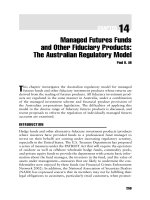Geography and Oceanography - Chapter 14 potx
Bạn đang xem bản rút gọn của tài liệu. Xem và tải ngay bản đầy đủ của tài liệu tại đây (6 MB, 38 trang )
Deep Ocean Circulation
Deep Ocean Circulation
Motion in the Ocean, Part 2,
“The Great Conveyor Belt”
Jack Barth
()
NASA web site:
Surface Circulation
Surface Circulation
Surface and Deep Ocean Circulation
help move heat from equator to pole
Atmosphere & Ocean each responsible for about
Atmosphere & Ocean each responsible for about
half of heat transfer
half of heat transfer
How does the Deep Ocean
How does the Deep Ocean
respond to Surface Circulation?
respond to Surface Circulation?
✦
The main gyres move heat and salt
✦
Resulting DENSITY variations lead to
vertical flow (sinking)
✦
Formation of “water masses”,
characterized by Temperature +
Salinity = Density
Density Variation in Sea Water
Density Variation in Sea Water
Isopycnals = constant density
Isopycnals = constant density
Density Variation in Sea Water
Density Variation in Sea Water
Nearly all the water in the oceans is cold
Nearly all the water in the oceans is cold
North Atlantic Surface Circulation
North Atlantic Surface Circulation
Density-Driven Water Flow
Density-Driven Water Flow
✦
Called “
Called “
Thermohaline Circulation
Thermohaline Circulation
”,
”,
because
because
temperature
temperature
and
and
salinity
salinity
together determine density of
together determine density of
seawater
seawater
“
“
Thermo
Thermo
” =
” =
temperature
temperature
“
“
haline
haline
” =
” =
salt
salt
Where does the Ocean’s
Where does the Ocean’s
Deepest Water Come From?
Deepest Water Come From?
✦
The densest seawater is
The densest seawater is
cold
cold
and
and
salty
salty
✦
This is formed at high latitudes in the
This is formed at high latitudes in the
North and South Atlantic:
North and South Atlantic:
North Atlantic Deep Water (NADW)
North Atlantic Deep Water (NADW)
Antarctic Bottom Water (AABW)
Antarctic Bottom Water (AABW)
Density of Sea Water
Density of Sea Water
Density Rules!
Density Rules!
Deep Water Masses
Deep Water Masses
Deep/bottom water formation sites
Antarctic Bottom Water (AABW) in Weddell,
Ross Seas and Adelie Coast
North Atlantic Deep Water
L. Talley (SIO)
Antarctic Bottom Water (AABW)
■
Weddell Sea major site of AABW formation
■
AABW circles Antarctica and flow
northward as deepest layer in Atlantic,
Pacific and Indian Ocean basins
■
AABW flow extensive
–
45°N in Atlantic
–
50°N in Pacific
–
10,000 km at 0.03-0.06 km h
-1
; 250 y
North Atlantic Deep Water (NADW)
■
Coastal Greenland (Labrador Sea) site of NADW formation
■
NADW comprises about 50% of the deep water to worlds
oceans
■
NADW in the Labrador Sea sinks directly into the western
Atlantic
–
NADW forms in Norwegian Basins
■
Sinks and is dammed behind sills
–
Between Greenland and Iceland and Iceland and
the British Isles
■
NADW periodically spills over sills into the North
Atlantic
Water Masses
Water Masses
and ocean
and ocean
mixing
mixing
determined by CTD
determined by CTD
(conductivity,
(conductivity,
temperature, depth)
temperature, depth)
measurements
measurements
Mediterranean Water
Mediterranean Water
Mediterranean Water
Mediterranean Water
Mediterranean Water
Mediterranean Water
Deep Atlantic Circulation
Deep Atlantic Circulation
This southward flow in one layer and northward flow below, with
vertical motion at either end is called the “Atlantic Meridional
Overturning Circulation (MOC)”
Ocean Circulation:
The Great Conveyor Belt
■
Surface water at high latitudes forms deep water
■
Deep water sinks and flows at depth throughout
the major ocean basins
■
Deep water upwells to replace the surface water
that sinks in polar regions
■
Surface waters must flow to high latitudes to
replace water sinking in polar regions
■
This Idealized circulation is called the “Great
(Thermohaline) Conveyer Belt”
Tracers in the Ocean
Tracers in the Ocean
✦
Track the motion (direction and
velocity)
✦
14
C, cosmic rays in the upper atmos
(half-life is 5700 years)
3
H, nuclear weapons testing
(half-life is 12.5 years)
CFCs, chlorinated fluoro-carbons –
banned in early 1970s
CFC Spreading in the Atlantic
•
2000 m depth
•
Deep Western
Boundary
Current
•
Red is model
result
The Great Conveyor Belt
The Great Conveyor Belt
Ocean Circulation and Climate
■
On long timescales, average ocean temperature
affects climate
■
Most water is in deep ocean
■
Average temperature of ocean is a function of
■
process of bottom-water formation
■
transport of water around ocean basins
■
Deep water recycle times is ~1000 y
– Thermohaline circulation moderates climate
over time periods of ~ 1000 y









